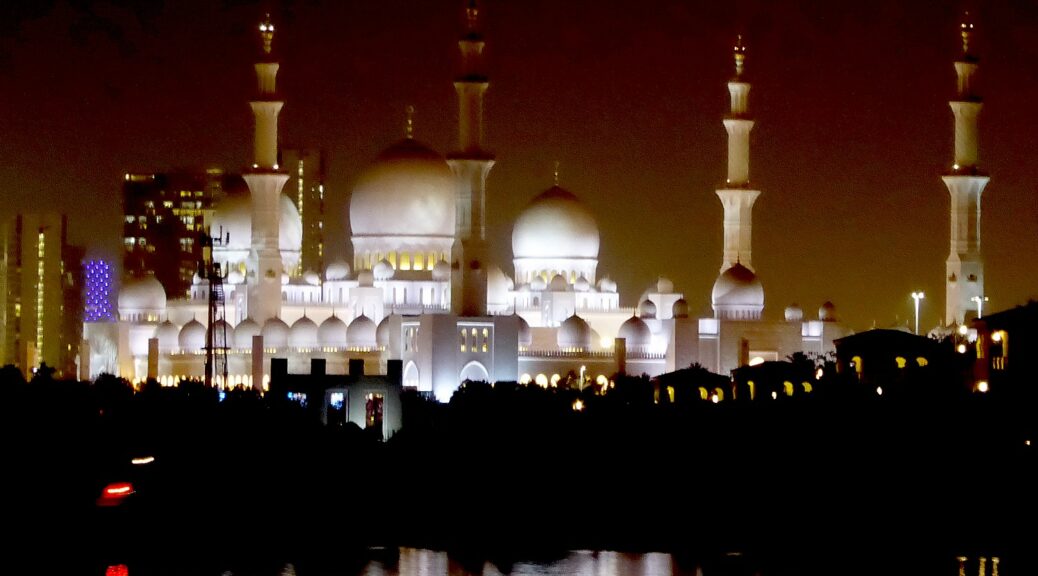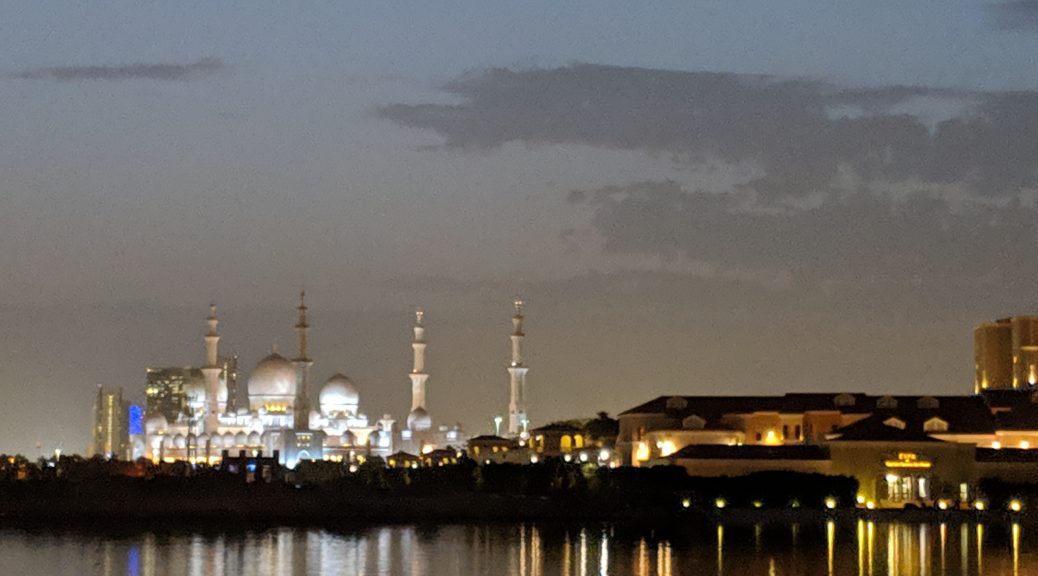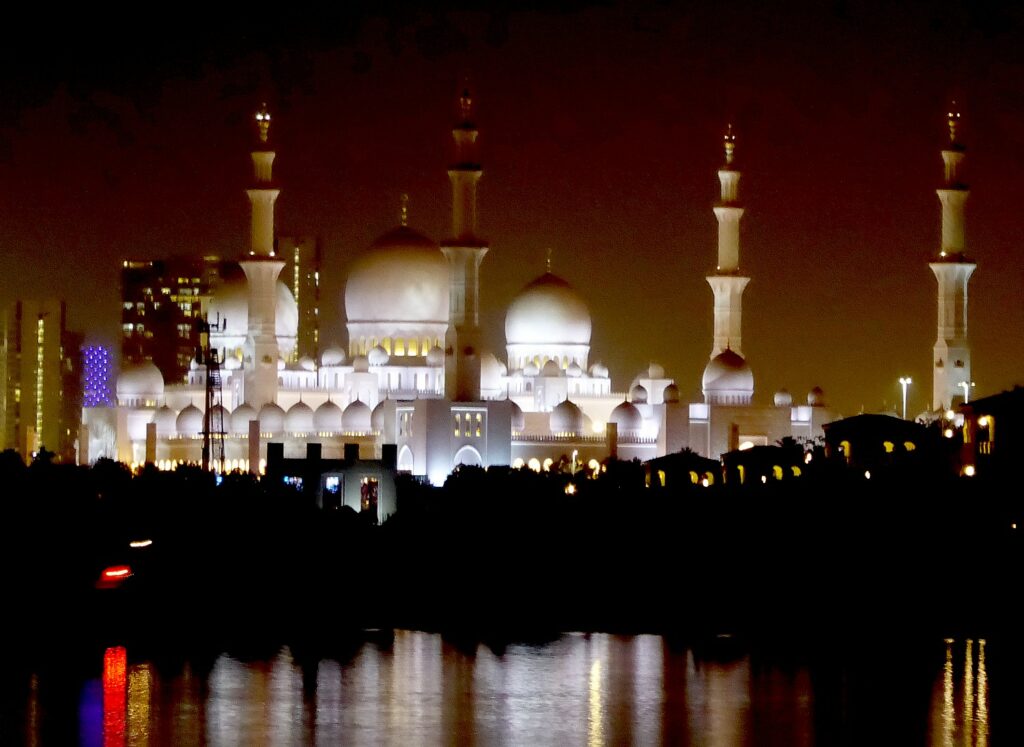
by Karen Rubin, Travel Features Syndicate, goingplacesfarandnear.com
Abu Dhabi is one of those places where the impression you have is either completely wrong or nonexistent. At least for me. Coming here on the Global Scavenger Hunt is yet another instance of proving what travel is all about: seeing, learning, connecting for yourself, and undoing stereotypes and caricatures.
Yes, Abu Dhabi is about conspicuous ostentation. That part of the pre-conception seems validated.
But what I appreciate now is how an entire nation state was built relatively recently out of a chunk of desert. The skyscrapers and structures have grown up here in a matter of decades, not centuries.
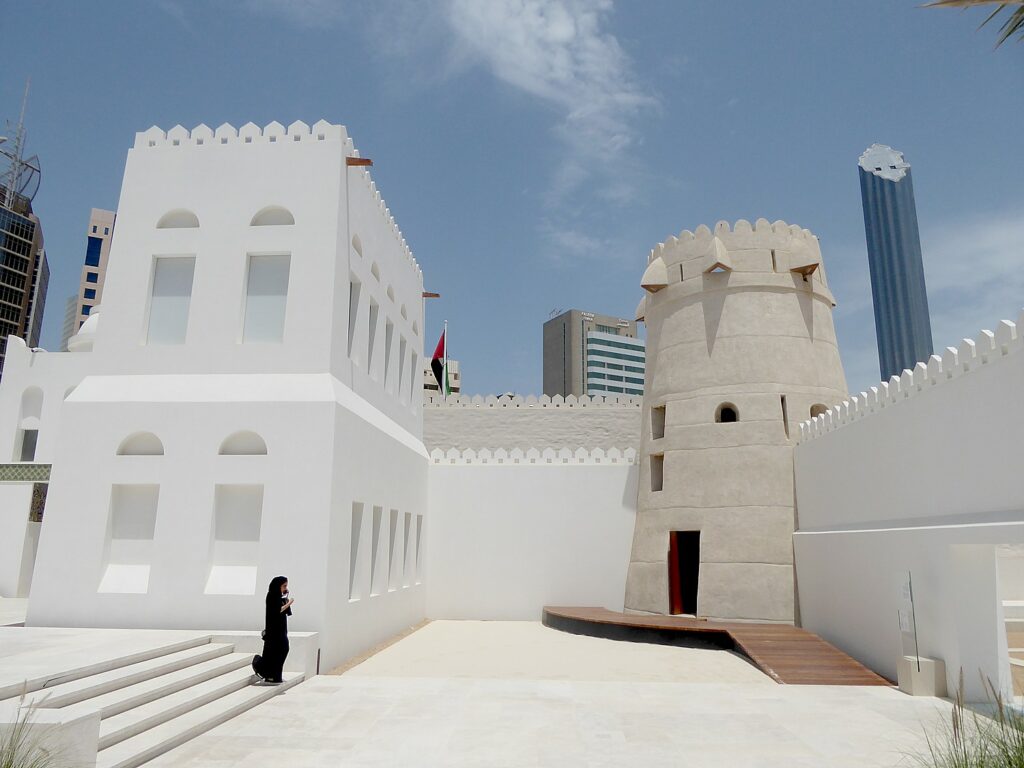
My first awareness comes visiting Fort Hassan, the original defensive fort and government building, and later the sheik’s residence built around (it reminds me of the White House, which is both the home of the head of government and government office). Fort Hassan has been restored (not rebuilt) and only opened to the public in December 2018. It provides the history of Abu Dhabi (https://qasralhosn.ae)
Qasr al Hosn, as it is properly called, is the oldest and most significant building in Abu Dhabi, holding the city’s first permanent structure; the watchtower. Built around the 1790’s, the commanding structure overlooked the coastal trade routes and protected the growing settlement established on the island.

It consists of two major buildings: the Inner Fort (originally constructed in 1795) and the Outer Palace (1939-45). Over the centuries, it has been home to the ruling family, the seat of government, a consultative council and a national archive; it now stands as the nation’s living memorial and the narrator of Abu Dhabi’s history.
Transformed into a museum in 2018 after more than 11 years of intensive conservation and restoration work, Qasr Al Hosn is a national monument that encapsulates the development of Abu Dhabi from a settlement reliant on fishing and pearling in the 18th century, to a modern, global metropolis, with displays of artifacts and archival materials dating back to as far as 6000 BC.
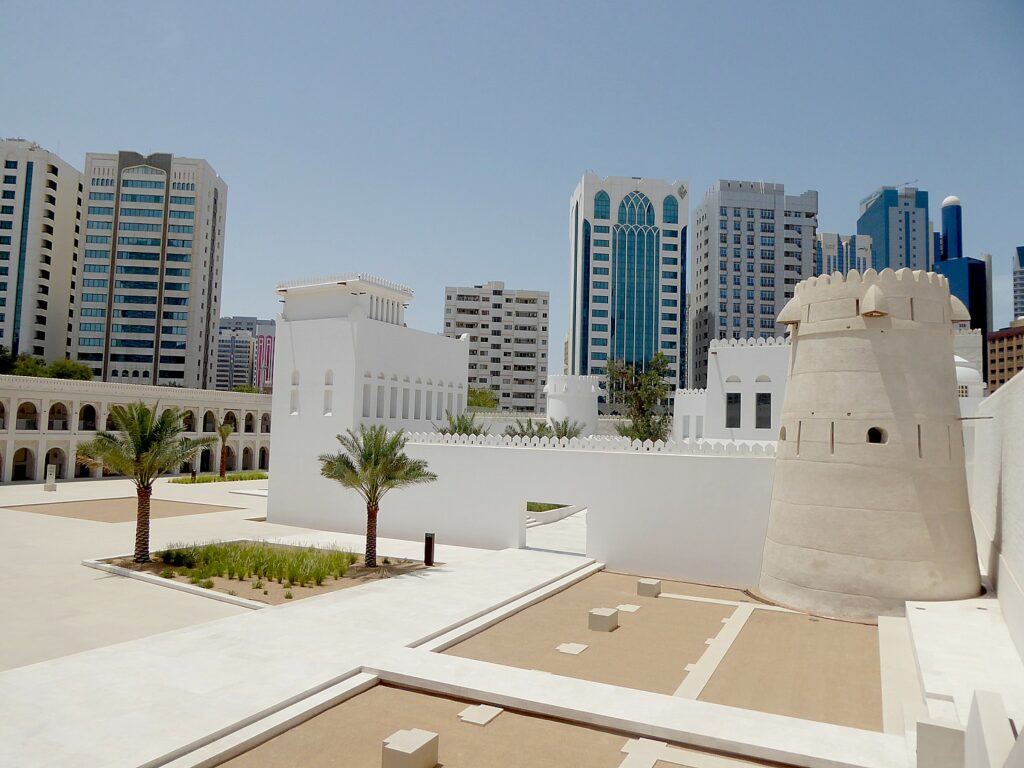
You see photos of how the fort/palace looked in 1904, with nothing but desert and a couple of palm trees around it. Today, it is ringed (yet not overwhelmed) by a plethora of skyscrapers, each seeming to rival the next for most creative, most gravity-defying, most odd and artful shape. It is like a gallery of skyscrapers (New York City Museum of Skyscrapers take note: there should be an exhibit) – for both their art and engineering. I note though that as modern as these structures are, they basically pick up and mimic some of the pattern in the old fort. And the building boom just seems to be going on.
And then you consider this: it’s all built on sand (and oil). “In 500 years from now, will these be here?” Bill Chalmers, the organizer of the Global Scavenger Hunt for the past 15 years, remarks. We had just come for Bagan, Myanmar, where the temples have been standing since the 11th century despite earthquakes and world events, and Yangon, where we visited the Schwedagon Pagoda that dates back 2,500 years.
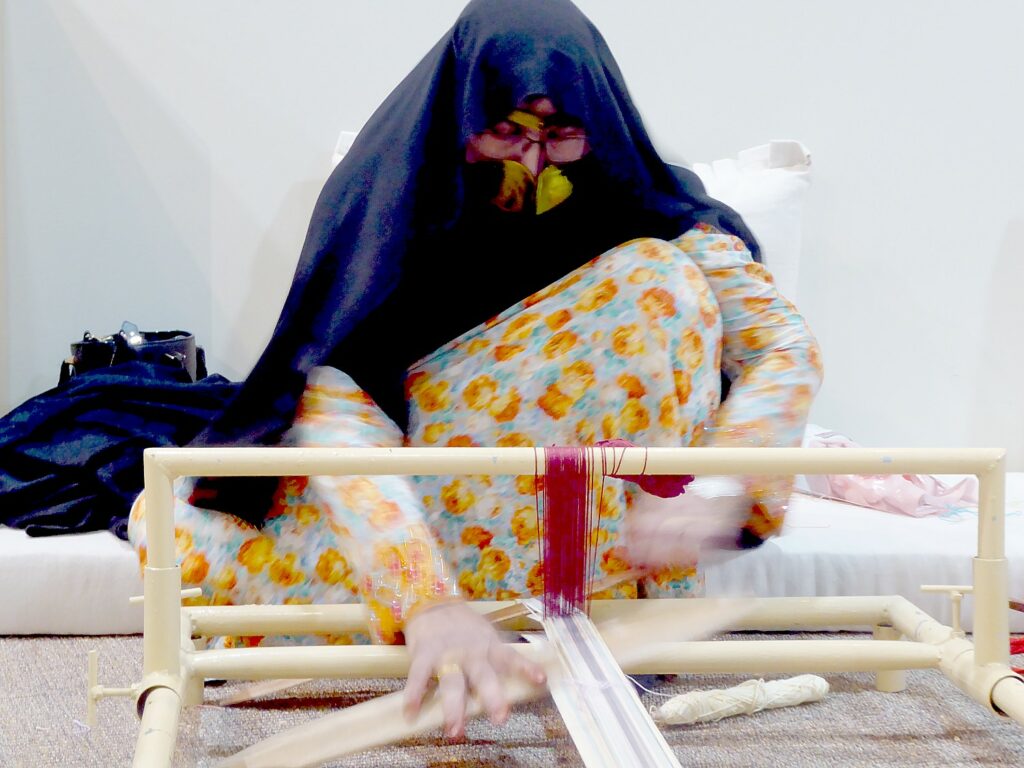
There is also a Hall of Artisans which begins with an excellent video showing how the crafts reflected the materials that were at hand (eventually also obtained through trade) and then you see women demonstrating the various crafts, like weaving. (Indoors, with very comfortable air-conditioning and facilities.)

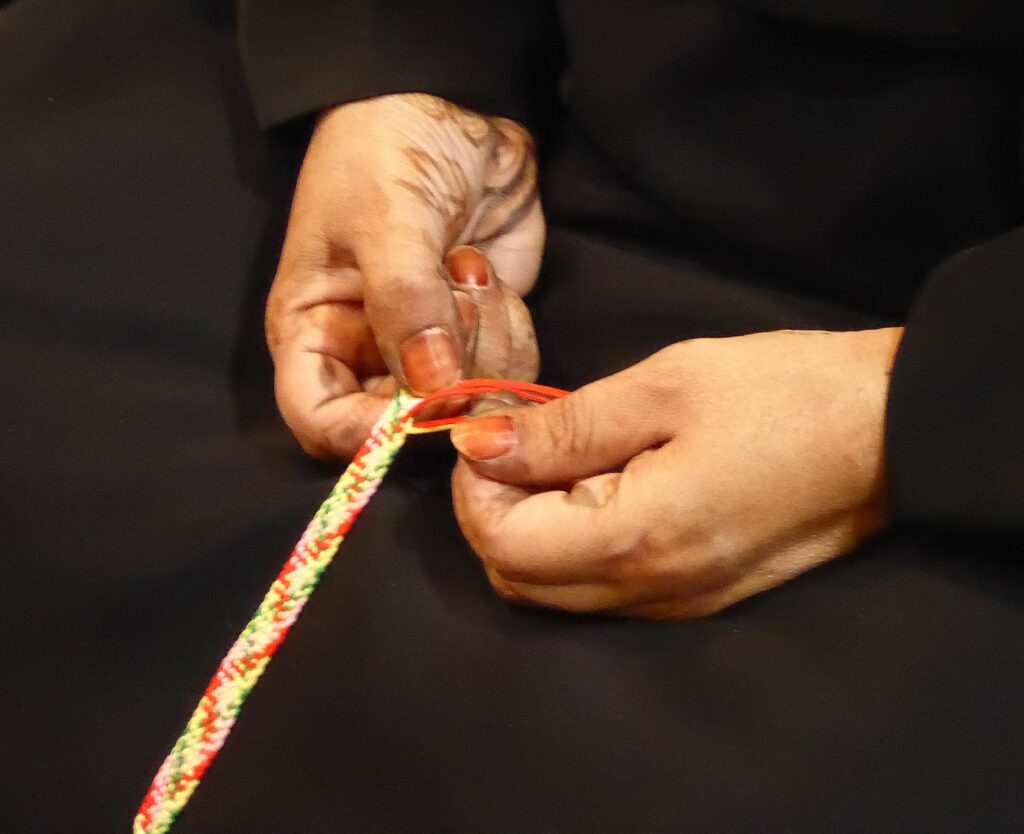
From there, I walk to a “souk” at the World Trade Center that had stalls of some traditional items – wonderful spices for example – but in a modern (air-conditioned comfort!) setting, and directly across the street from a major modern mall promising some 270 different brand shops. Souks are aplenty here.
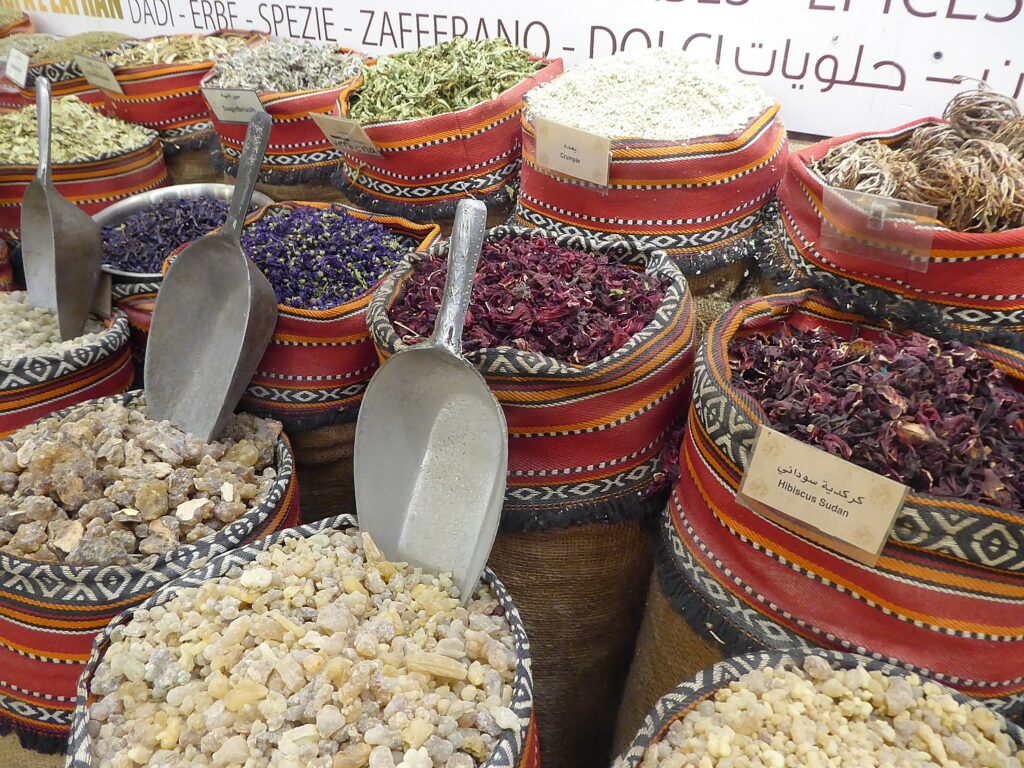
My walk lets me revel in the skyscape. I come upon an intriguing road sign pointing toward the Federal Authority for Nuclear Regulation.
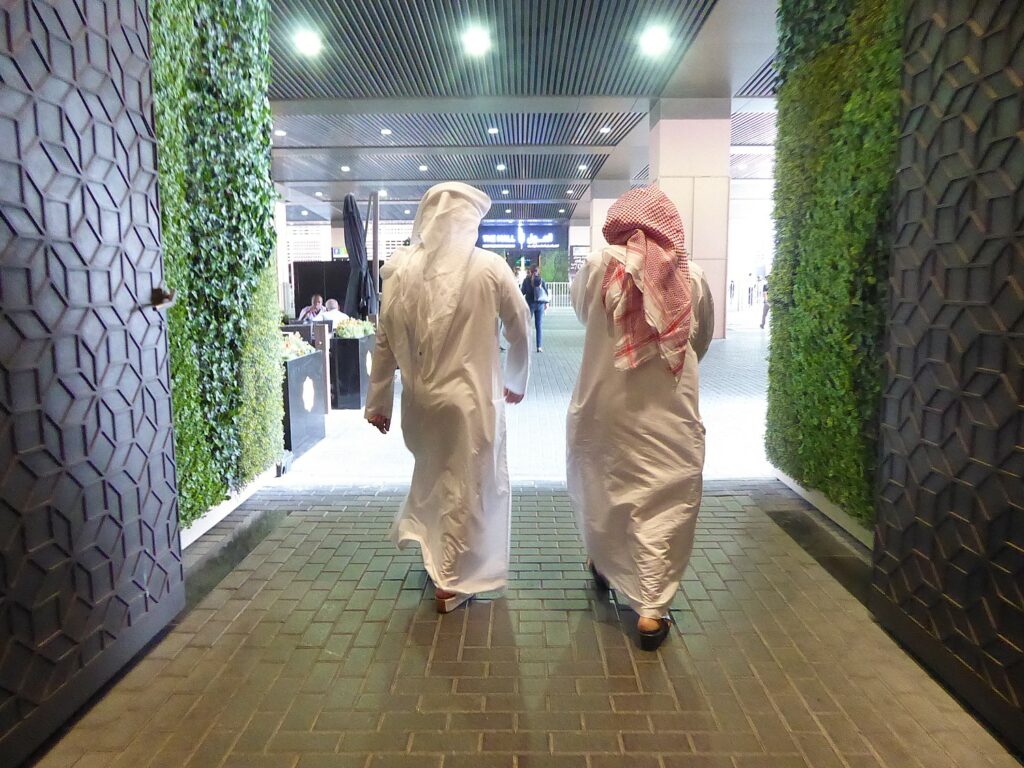
Falcon Hospital
I find myself dashing to get to the Abu Dhabi Falcon Hospital, where I had pre-booked the 2 pm tour. I didn’t realize how far it is from downtown – a 35-minute drive. The taxi driver, who I learn was recruited to come work in Abu Dhabi from his home in Ghana along with many other young men, and lives in an apartment building with other migrant workers, has to stop for gas and I worry I will miss the tour altogether.
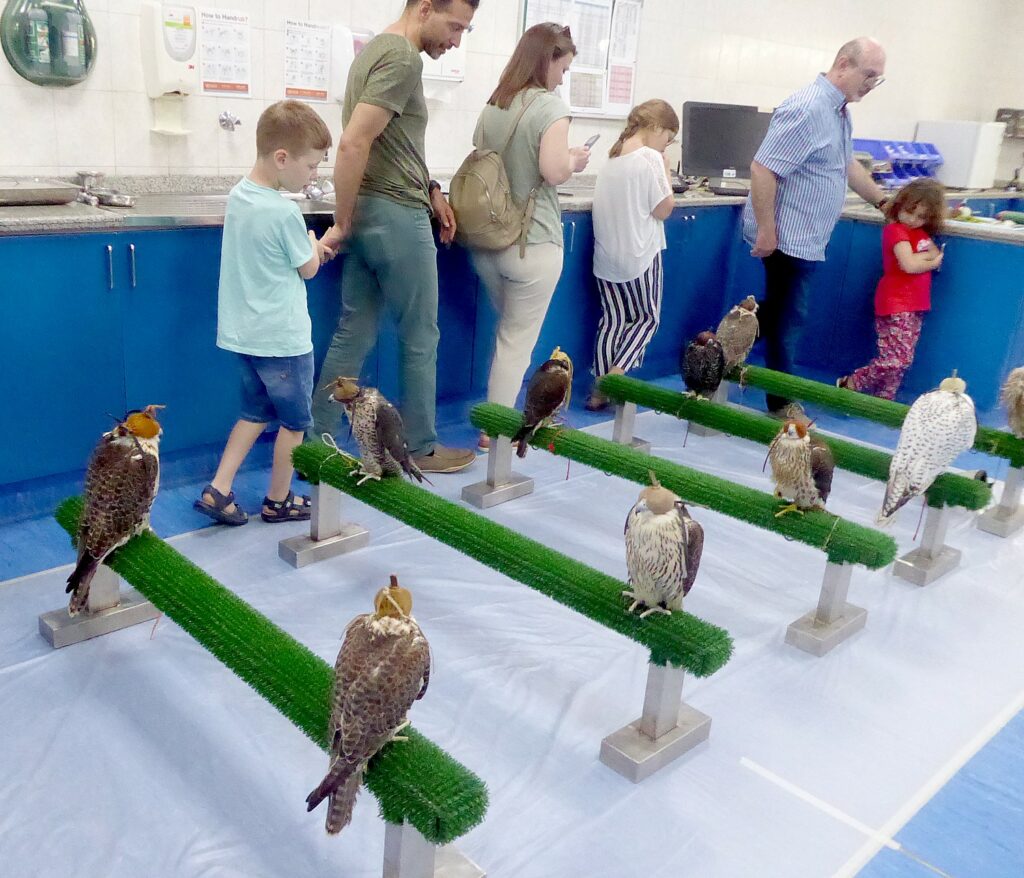
The visit to the Falcon Hospital is truly a highlight of a visit to Abu Dhabi. It is fascinating to learn how these prized birds are handled. We are taken into the treatment area, surprised to see a couple of dozen hooded falcons, waiting patiently in what is a waiting room for their “appointment”. Their owners drop them off for the day for whatever checkup or healthcare they require; others stay in the falcon hospital (the biggest in Abu Dhabi and one of the biggest in the world), for months during their moulting season, when, as wild falcons, they would otherwise live in the mountains for six months. They are provided the perfect cool temperatures they would have in that habitat, before coming to the desert in spring to hunt, and later to breed.

We get to watch a falcon being anesthesized – they quickly pull off his hood, at which point he digs his claws into the gloved hand holding him, and his face is quickly stuffed into the mask and put to sleep. His claws, which normally would be shaved down in the wild, become dangerously overgrown in captivity; the falcon doctor also shows how they can replace a feather that has become damaged, possibly impeding the bird’s ability to fly or hunt (they can carry prey four times their weight). The feather has to be an exact match, which they match from the collection of feathers from previous moultings. Then we get to hold a falcon. Not surprisingly this is one of the scavenges on the Global Scavenger Hunt (worth 35 points in the contest to be named “World’s Greatest Traveler”).
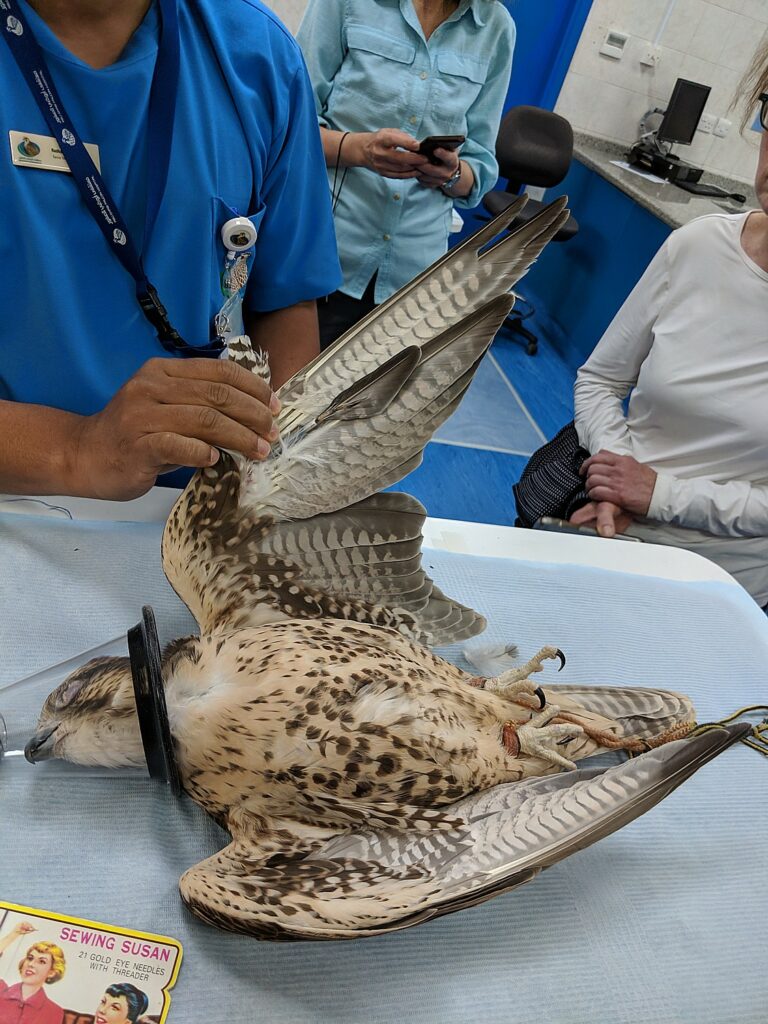
A falcon being treated at the Abu Dhabi Falcon Hospital © Karen Rubin/goingplacesfarandnear.com
We learn that the Abu Dhabi Falcon Hospital (ADFH) is the first public institution in the United Arab Emirates providing comprehensive veterinary health care services exclusively for falcons. It was established by the Abu Dhabi’s Environment Agency and opened in October 1999. The Abu Dhabi Falcon Hospital has become the largest falcon hospital in the United Arab Emirates and in the world, caring for 11,000 falcons a year and more than 110,000 patients since its opening.
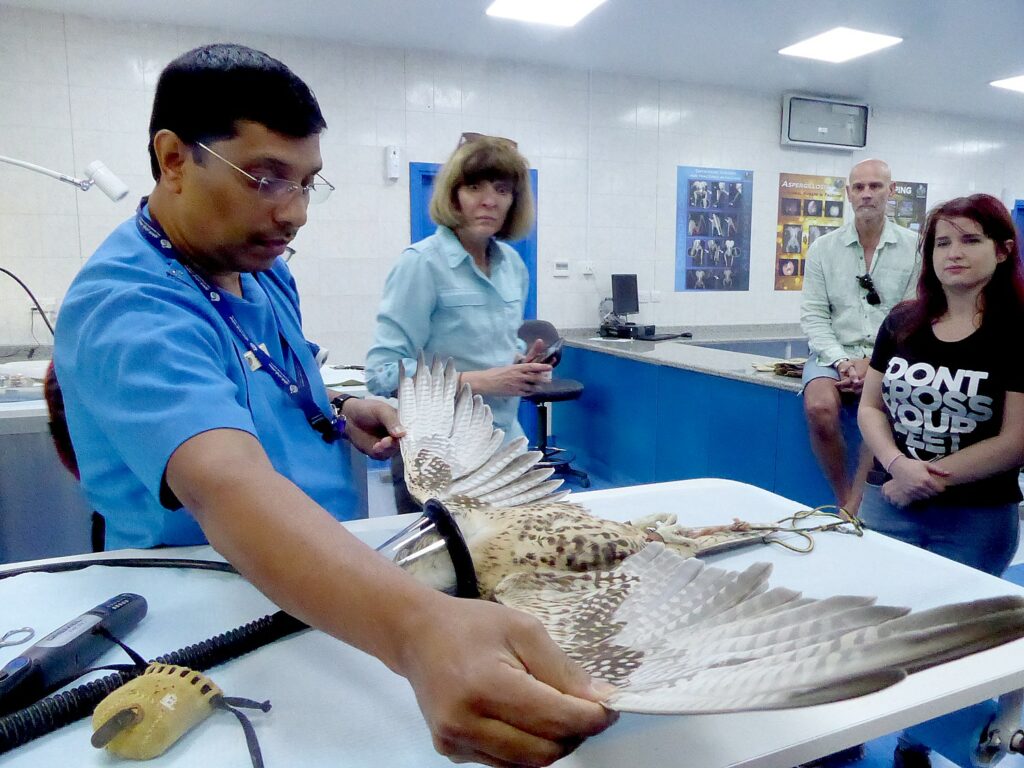
From being established as a purely veterinary facility, the ADFH has expanded in the fields of education and awareness, training and research. Due to the huge demand the falcon hospital has became a full-fledged specialized avian hospital for all kinds of birds and poultry species in 2006. In 2007, it added services for a wide variety of VIP pets and in 2010 opened an animal shelter. In 2011, it began its own falcon breeding program and breeds Saker falcons for the H.H. The Late Shk Zayed Falcon Release Program.
In 2007, ADFH opened its doors to what has become an award-winning tourism program and has become the most important tourist attraction in Abu Dhabi – for good reason.
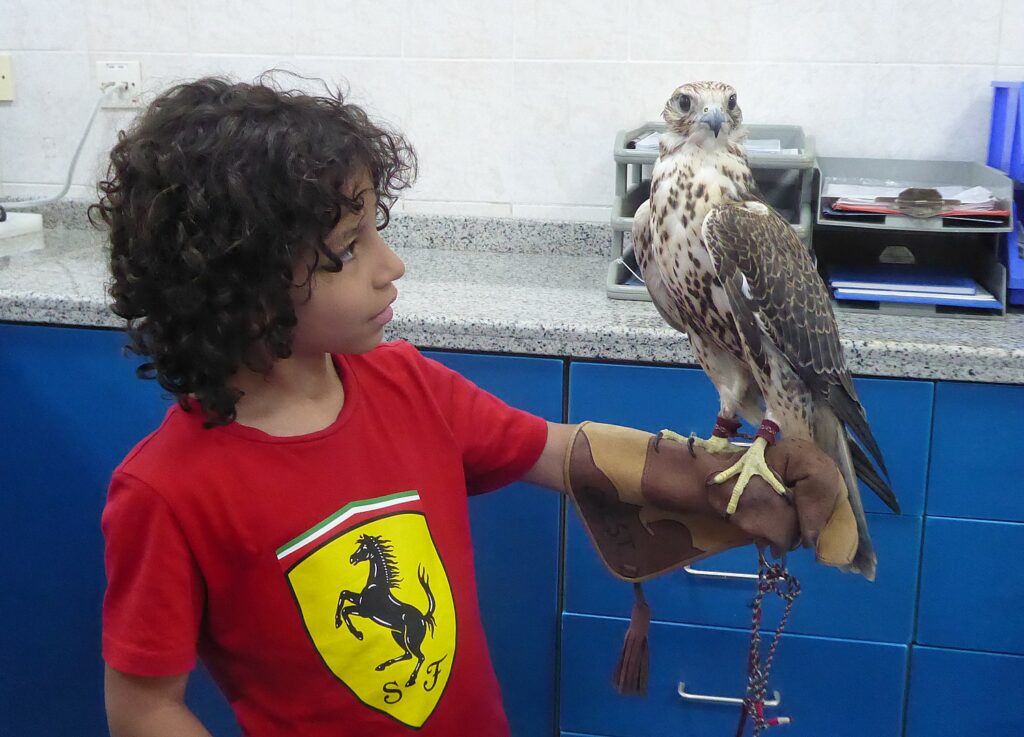
It is a thrilling and unique experience. I meet a woman from Switzerland who is engaged in a four-week internship at the falcon hospital, learning how to handle and care for the falcons – information she will bring back as a high school teacher. She tells me the falcons are very kind and gentle and bond with their owner. The feeling is clearly reciprocal – these prized falcons, which can cost up to $1 million, can fly on an airplane in the first class cabin with their owner (they have to have their own passport to prevent illegal trafficking), have their own seat and their own menu (fresh killed meat).
The Grand Mosque
Next I go to the Sheikh Zayed Grand Mosque – an experience that is not to be believed. If you thought the Taj Mahal was magnificent, a wonder of the world, the Grand Mosque which was built in 1999 and uses some of the same architectural and decorative design concepts, vastly surpasses it, in architectural scale and in artistic detail. Not to mention the Taj Mahal is basically a mausoleum, while the Grand Mosque is a religious center that can accommodate 7800 worshippers in its main sanctuary, 31,000 in the courtyard and altogether up to 51,000 worshippers for such high holy days as Ramadan. At more than 55,000 sq. meters it is the largest mosque in the United Arab Emirates and one of the largest in the world. And every cubic meter of it spectacularly decorated – the courtyard is one of the largest mosaics in the world.
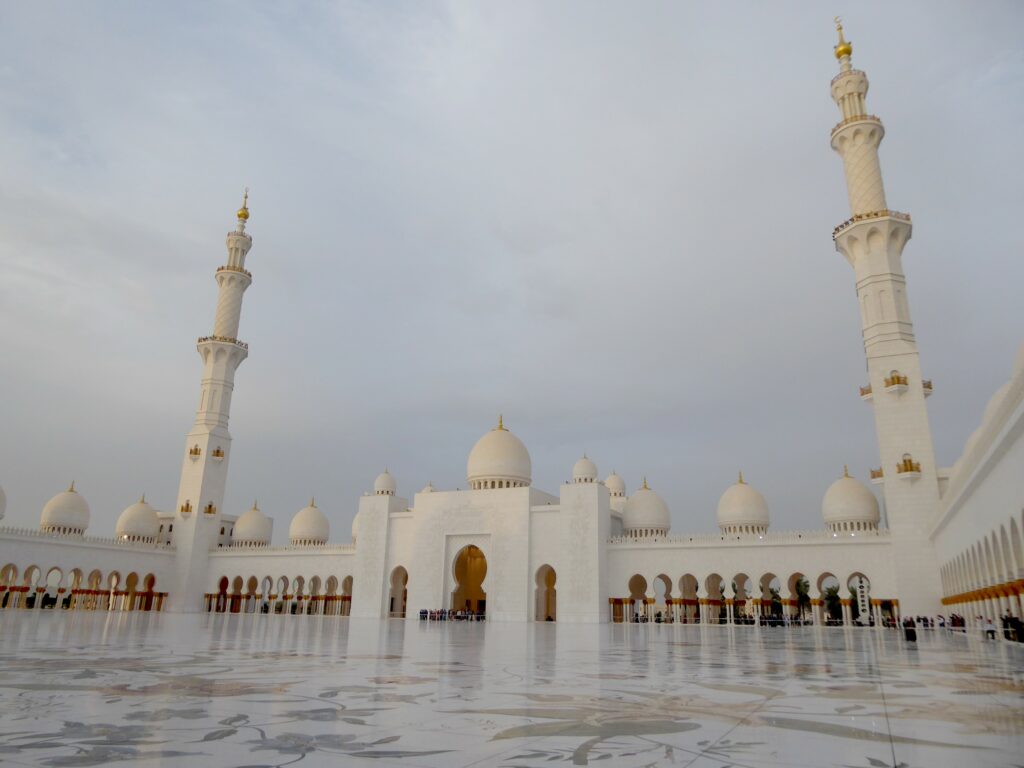
I time the visit to arrive about 4:30 pm in order to be there at dusk and sunset – and go first to what is labeled “the Visitors Happiness Desk” – how could I resist? The two gentlemen who manned the desk (surprisingly who are natives of Abu Dhabi when 88 percent of the population here come from some place else) are extremely well suited to their role – extremely friendly, helpful. As I am asking my questions, who should come down the escalator but my Global Scavenger Hunt teammate (small world!), so we visit together.
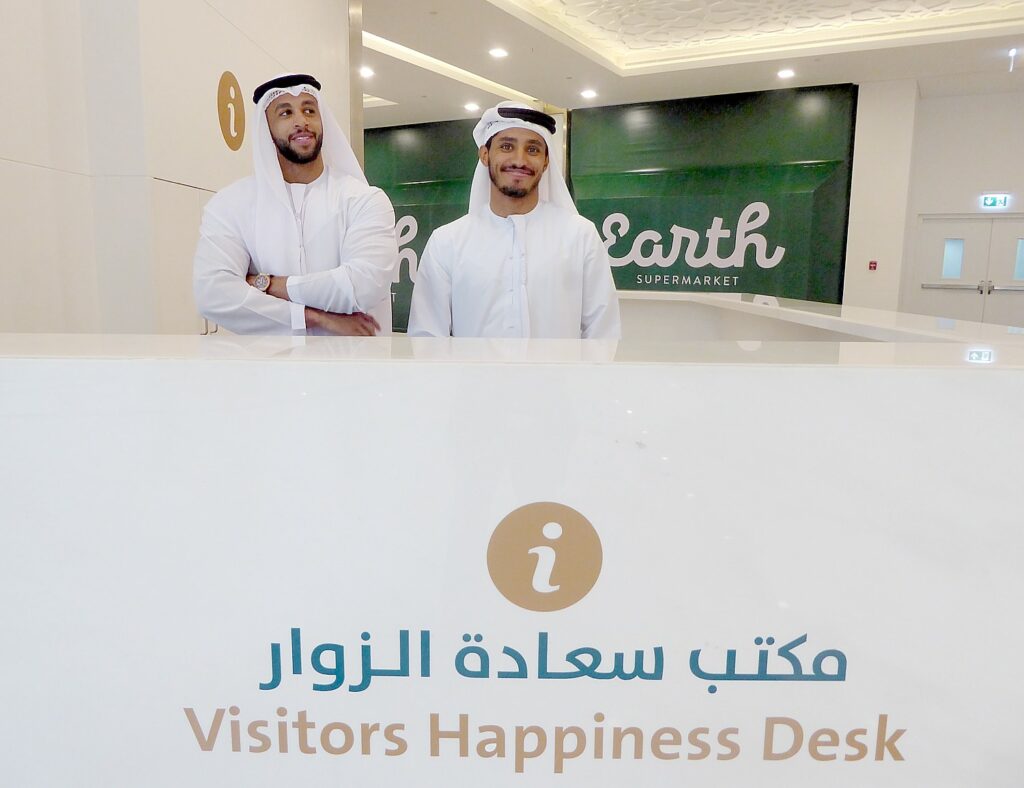
The experience of visiting is surprisingly pleasant, comfortable, welcoming – not austere as I expected (especially after having visited Buddhist temples in Myanmar where even when the stones are hot enough to fry an egg, you have to walk completely barefoot). Women must be fully covered, including hair, but they provide a robe (free). (I look like Mickey Mouse in the Sorcerer’s Apprentice.)
Indeed, the Sheikh Zayed Grand Mosque “aims to cultivate interaction between Islam and world cultures… Sheikh Zayed’s vision for the Grand Mosque was to incorporate architectural styles from different Muslim civilizations and celebrate cultural diversity by creating a haven that is truly diverse and inspirational in its foundation. The mosque’s architects were British, Italian and Emirati, and drew design inspiration from Turkey, Morocco, Pakistan, and Egypt among other Islamic countries, to create this glistening architectural marvel accommodating 40,000 worshippers and visitors at a time.
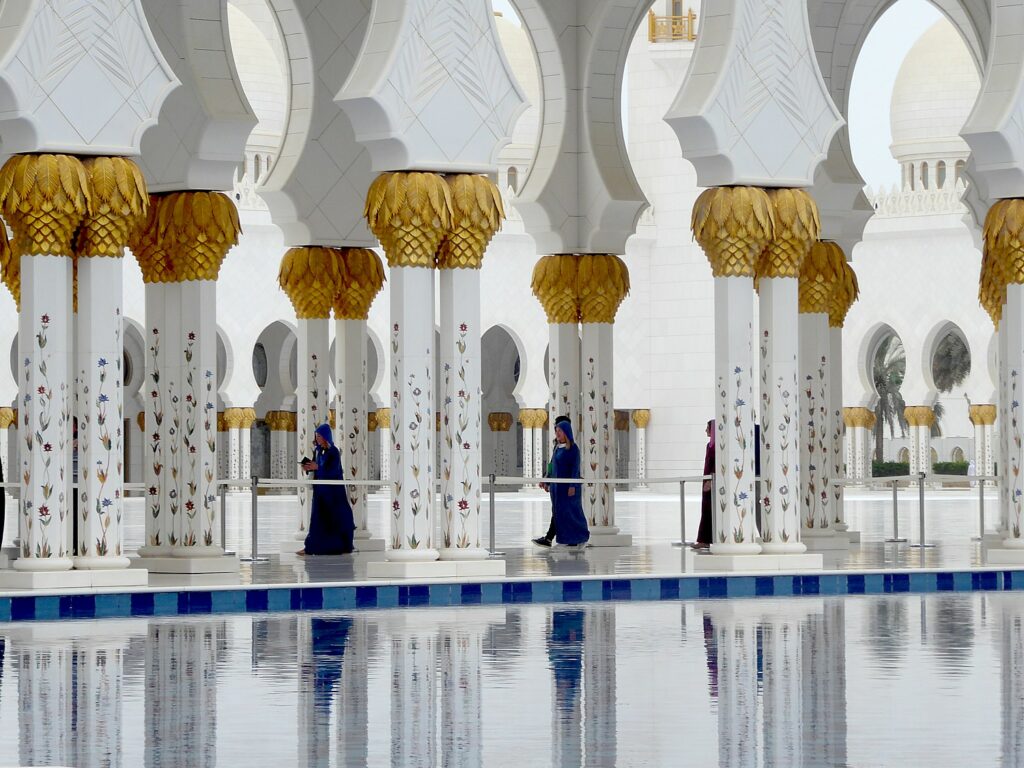
“The open-door policy invites tourists and celebrants from all around the world who can witness the spectacular onion-top domes, the reflective pools that engulf the courtyard and the iconic prayer hall, which not only overflows with blissful sunlight, but also houses the world’s biggest chandelier and carpet, both meticulously handmade. Be sure to spot the calligraphy encircling the hollows of the domes, etched with verses from the Quran and painted with gold leaves in An-Naskh lettering.”
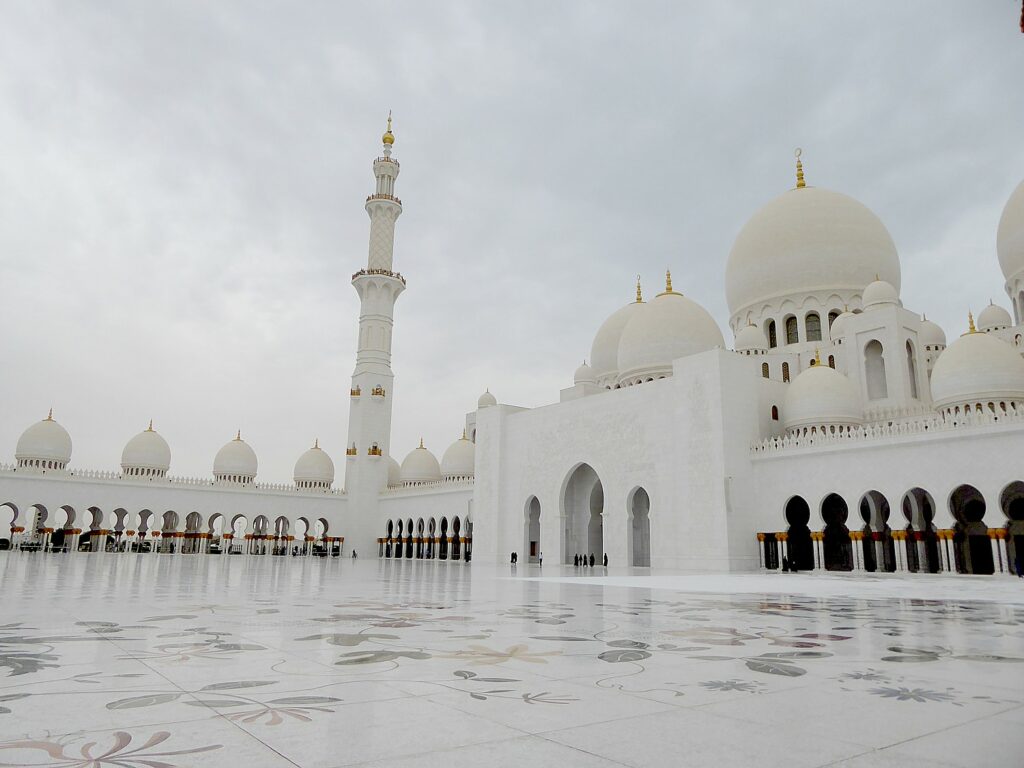
When you arrive at the Visitors Center, which is at some distance from the mosque, you walk underground to where there is an air-conditioned mall, with restaurants and shops, then go through a tunnel like an airport (an electric cart is available for those who can’t walk distances; it kind of reminded me of how Disney moves its visitors into its attractions).
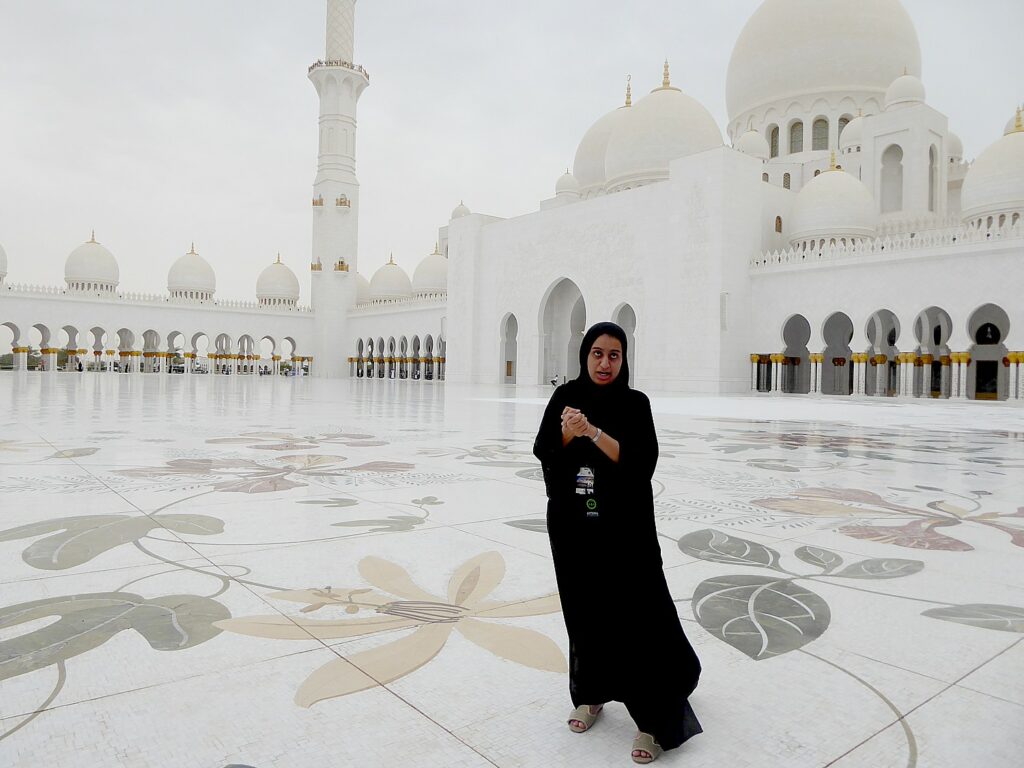
The public tour (an absolute must) is also free, indeed, the admission ticket to the Grand Mosque is free. (Fortunately, Margo manages to get us on the last public tour of the day which had already left, getting the guard to let us slip under a barrier.) Our guide is a delightful young woman who cheerily walks us through and points out the amazing art and details. The mosque is massively large in scale, but looks remarkably delicate.
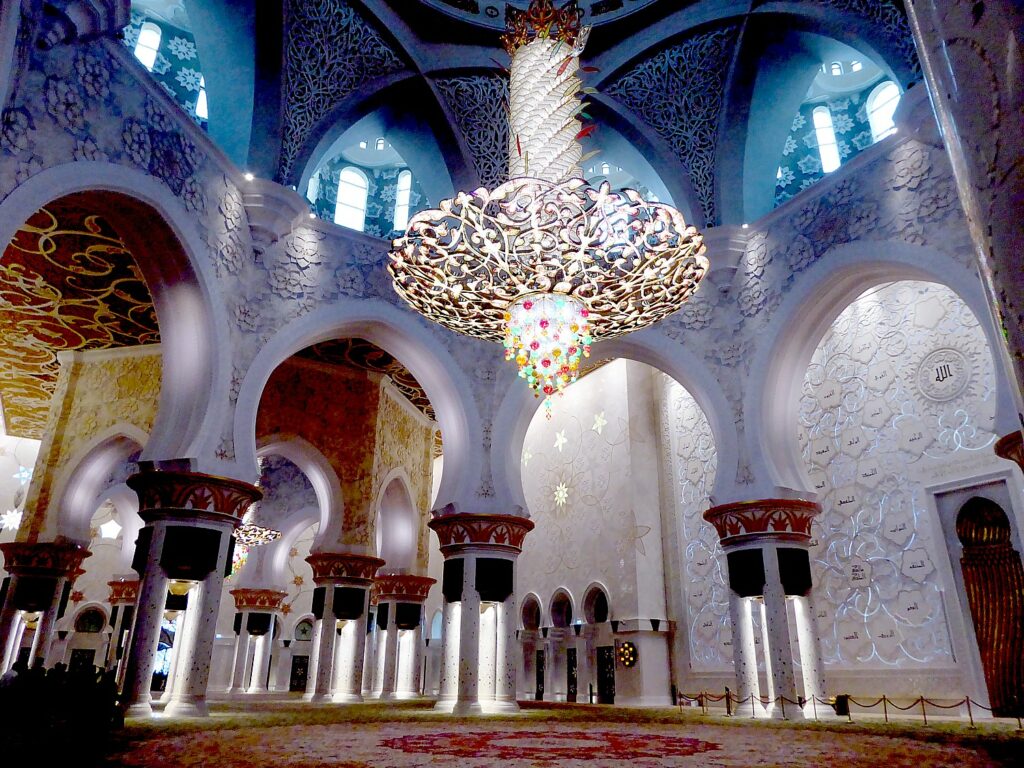

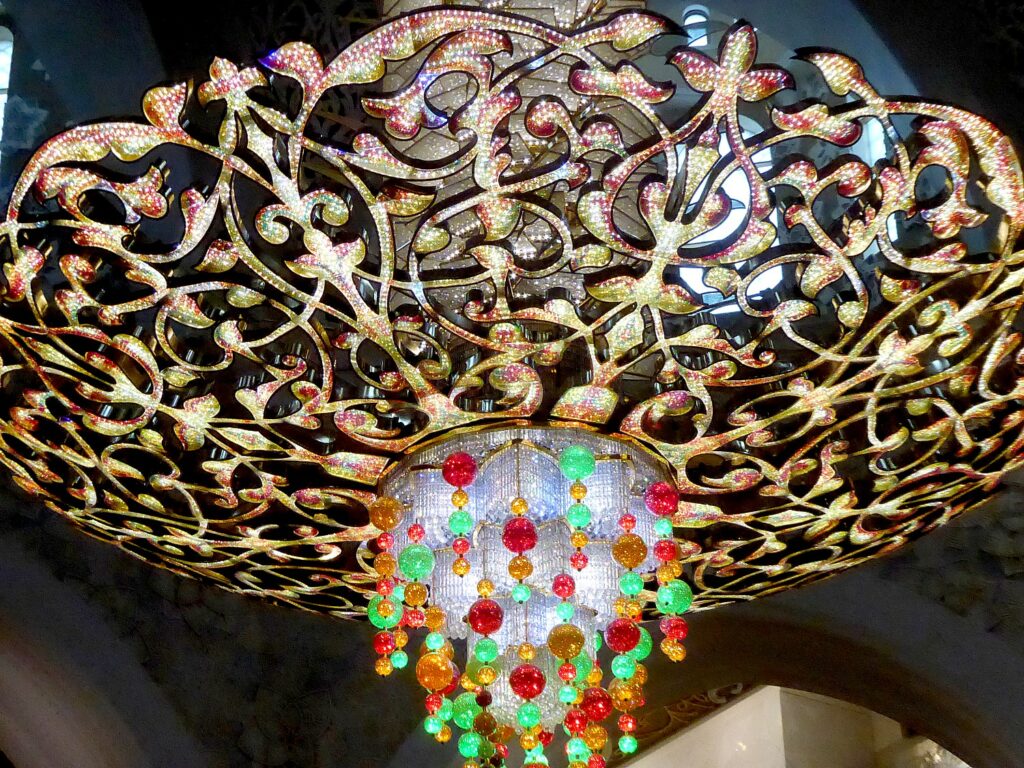
Just as we leave a touch of sunlight breaking through clouds that make the structures even more beautiful, if that were possible. By the time we get outside, the lights have come on (www.szgmc.gov.ae/en/Home ).
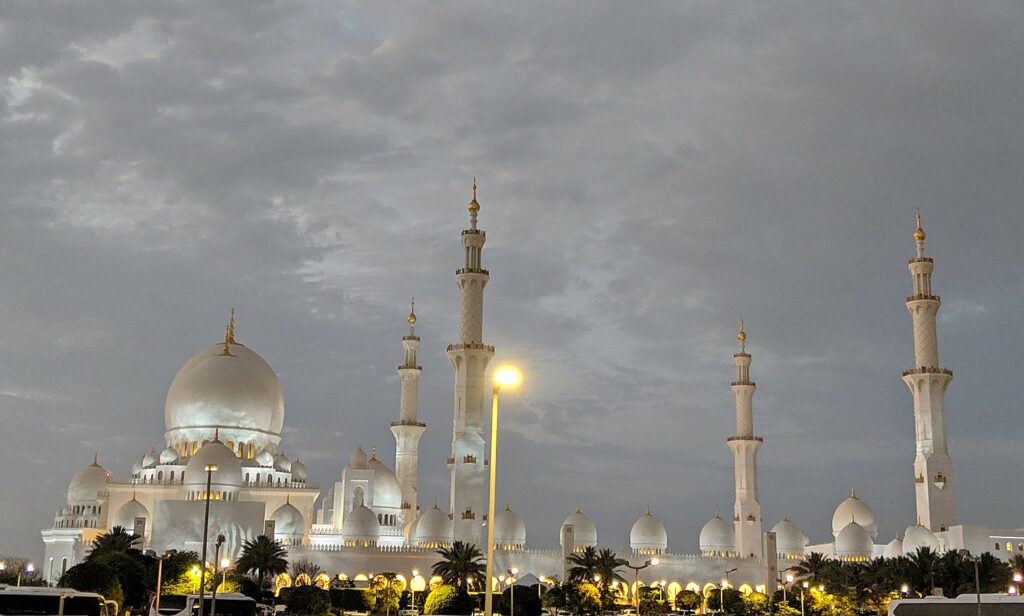
I ask the Happiness guys where to go for the best view of the Grand Mosque after dark, and, instead of the adjacent hotel where I had first been directed, they point us to The Souk at Qaryat (Al Beri), just across the water from the mosque. Sure enough, the view is spectacular.
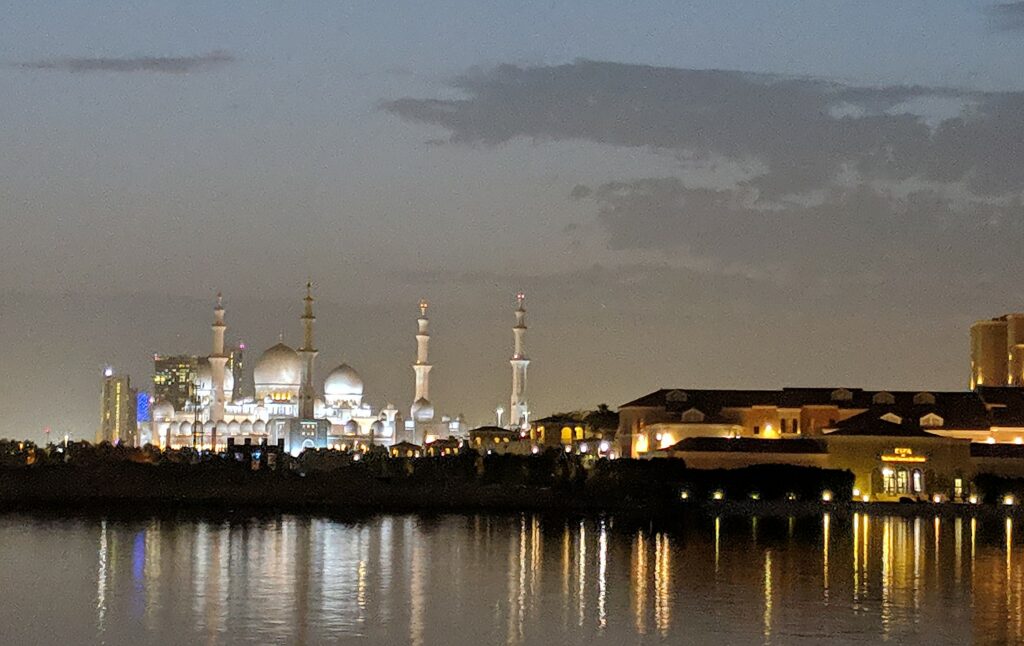
Global Scavenger Hunt Challenges
We had arrived in Abu Dhabi about midnight local time the night before, after having left our hotel in Myanmar at 5:15 am, flying an hour to Bangkok where we had an eight-hour layover challenge (I only managed to do a water taxi on the canal and explore the Golden Mountain and some buildings and watched preparations for the King’s coronation (I later heard it was for a parade that day). Then flew six hours to Abu Dhabi where we gained 3 hours (that is how we make up the day we lost crossing the International Dateline and why it is so hard to keep track of what day or time it is), so for us, midnight was 3 am. Bill Chalmers, the organizer, ringmaster and Chief Experience Officer of the Global Scavenger Hunt tells us this was the most arduous travel day we would have (and the 18 hours travel from Vancouver to Vietnam was the longest airline trip).
We have had a full day in Abu Dhabi to do our scavenges. Tonight’s scavenger hunt deadline is 10 pm, when we will learn where our next destination will be on the 23-day day mystery tour. Only five of the original nine teams are still in contention to win the title, “World’s Best Traveler” (and free trip to defend the title next year).
The scavenges are designed to give us travel experiences that take us out of our comfort zone, bring us closer to people and immerse us in cultures. In Abu Dhabi, one of the experiences that would earn 100 points is to be invited for dinner with a family in their home. “It is always a good thing to be invited for dinner with a family in their home. If you are, and you do – please do bring something nice for them, be patient and be gracious. Of course, we want proof.”
Another is to “hold an informal majlis with actual locals (people actually from UAE and not at any hotel) over an Arabica coffee; talk about a few things like the future of Abu Dhabi, oil, tourism, arranged marriages, Western values, etc.” That would earn 35 points.
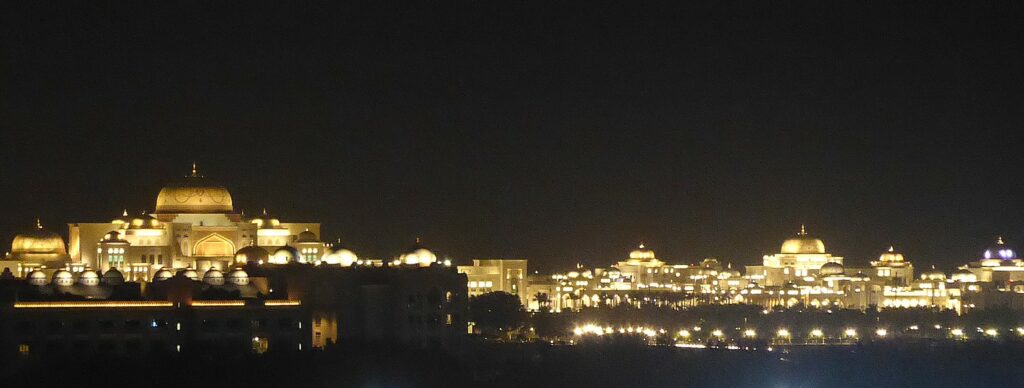
Other possibilities: ride “the world’s fastest rollercoaster” (75 points – Paula and Tom, the SLO Folks and returning champions, did that and said it felt like 4G force); walk the Emirates Palace from end to end and have a “golden cappuccino” (they literally put gold flakes in the cappuccino, this is Abu Dhabi after all) for 35 points; take in the grandeur of the Presidential Palace, only recently opened to the public, and visit Qasr Al Watan, a building within the compound dubbed “’Palace of the Nation” (complete with huge white domes, lush gardens and dramatic chandeliers, the new landmark is intended to give visitors a stronger understanding of the UAE’s governing traditions and values. There is also a spectacular nightly show.) (50 points).
Many of the scavenges (including mandatory ones) have to do with local food, because foods and food preparations are so connected to heritage, culture and environment and bring people together. One of the scavenges here is to assemble three flavors of camel milk from a grocery store and do a blind taste test (35 points).
Unfortunately, an attraction we all wanted to visit, the Louvre Abu Dhabi, was closed. The museum, which opened in November 2017, is a collaboration with the famous Louvre of Paris, France, and intended to be a “universal museum in the Arab World,” focusing on “what unites us: the stories of human creativity that transcend individual cultures or civilizations, times or places.”
The pioneering cultural project combines “the UAE’s bold vision of cultural progression and openness with France’s expertise in the world of art and museums.” The museum was expected to exhibit Leonard Da Vinci’s Salvator Mundi, considered the most expensive painting in the world (purchased for $450 million at auction in November 2017, believed by Saudi Crown Prince Mohammed bin Sulman), but delayed the exhibition. (www.louvreabudhabi.ae)
A lasting impression that I will carry away from this brief visit to Abu Dhabi is that its theme this year is “Year of Tolerance” which also goes to what we have experienced here: attractions and programs intended to promote understanding of Islamic history, heritage and culture.
Our accommodation in Abu Dhabi is the five-star St. Regis (just about all the accommodations arranged for the Global Scavenger Hunt are five-star), which serves the most extravagant breakfast. Purposefully, our ringmaster and Chief Experience Officer, Bill Chalmers, has arranged it so we will have two, lavish breakfasts here, much to our collective delight.
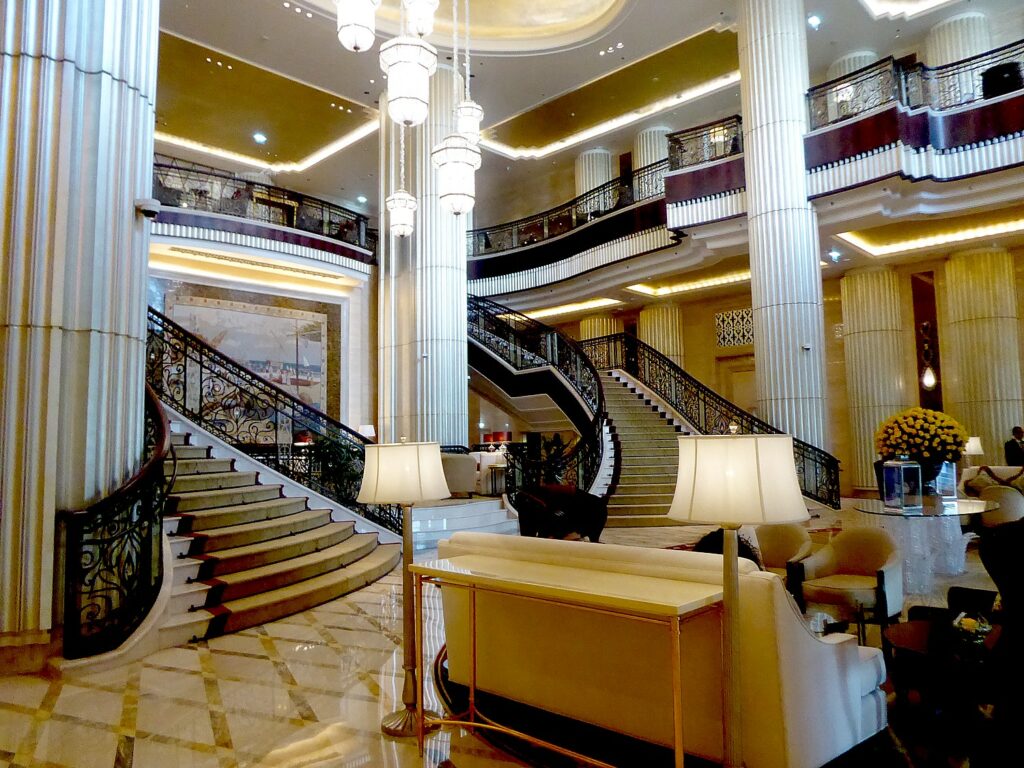
The hotel has a stunning rooftop pool and bar (what a view!) and is connected by a tunnel under the busy boulevard to the beach on the Persian Gulf.
We gather together at 10 pm in the lavish lobby of the St. Regis, excitedly trade stories about our travel adventures during the day. Inevitably, I am jealous of the things I didn’t do, couldn’t fit in to do – like visiting the Fish Market, the Iranian Souk, the Presidential Palace! (can’t believe I missed that), built for the tidy sum of $5 billion (open til 7 pm, then a lightshow at 7:30 pm).
And then we learn where we are going next: Jordan!
More information on visiting Abu Dhabi at https://visitabudhabi.ae/en/.
The Global Scavenger Hunt is an annual travel program that has been operated for the past 15 years by Bill and Pamela Chalmers, GreatEscape Adventures, 310-281-7809, GlobalScavengerHunt.com.
________
© 2019 Travel Features Syndicate, a division of Workstyles, Inc. All rights reserved. Visit goingplacesfarandnear.com, www.huffingtonpost.com/author/karen-rubin, and travelwritersmagazine.com/TravelFeaturesSyndicate/. Blogging at goingplacesnearandfar.wordpress.com and moralcompasstravel.info. Send comments or questions to FamTravLtr@aol.com. Tweet @TravelFeatures. ‘Like’ us at facebook.com/NewsPhotoFeatures
